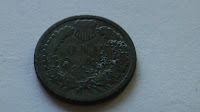Decided to try my coil around an area of the oldest park in town which does not get any attention. By "attention" I mean a section that virtually never gets any modern human activity and as such there are few changes made to it over the years. So I started off where I left the last time I was there and came across a 1944 wheat penny. About 20 minutes into the hunt, I got a strong signal which was very similar to my Mercery dime discovery - right on the money! This time it was older -- 1923 -- and in fairly good condition.
The next possible signal I got did not even seem like anything special. It was "iffy" at best. For any Xterra owners out there, the best I can describe it is a faint signal (as in, it barely overcame my threshold tone) and had a very narrow window that you hear it. The difference between this possibly good signal and a high VDI (42-46) signal from some aluminum scraps was the fact it was CONSISTENT at all types of angles swinging the coil. Junk will not behave like this, instead giving a much more erratic signal. The difference is subtle hopefully I now have a better feel for this in the field.
Anyway, what happened next can only be described as the greatest set of finds in my detecting career to this point. About 5-6inches down in very compacted and dry soil, my glove revealed the silvery edge of a large coin with stars around the perimeter. Could it be what I thought it was? Oh yes, I laid my eyes on my very own Barber quarter - 1902!!
My oldest coin to date. I swung over the hole again. There was still a signal coming out of there - you have got to be kidding me! My pinpointer guided me to more shiny silver off to the edge of where I made my plug. This time I was rewarded two fold... another Mercury dime - 1918 and sandwiched with it was my very first standing liberty quarter. But as I pulled it out I realized my screwdriver I had used to loosen the compacted dirt had scrapped the 3 o'clock position, taking out the E Plurus unum. The coin had enough wear on it to make the date unreadable but the reverse revealed it to be minted after 1917 (Type II).
Now no more than a foot from this three silvers in one hole was a solid penny signal near a tree that I decided to dig to see if it was a wheatie. At first glance, I knew it was not a wheat penny. The reverse was the back of my first Indian Head Penny! The obverse had some gunk on it so I waited to clean it at home. Imagine my surprise as I revealed the date - 1883! My oldest coin to date. It is going to take some time before I get down from this "cloud nine."
I can only hope that I have finally figured out how to read silver with my machine because now all I can think about is getting my next piece.








No comments:
Post a Comment